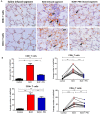The efficacy and safety of pinocembrin in a sheep model of bleomycin-induced pulmonary fibrosis
- PMID: 34855848
- PMCID: PMC8638960
- DOI: 10.1371/journal.pone.0260719
The efficacy and safety of pinocembrin in a sheep model of bleomycin-induced pulmonary fibrosis
Abstract
The primary flavonoid, pinocembrin, is thought to have a variety of medical uses which relate to its reported anti-oxidant, anti-inflammatory, anti-microbial and anti-cancer properties. Some studies have reported that this flavonoid has anti-fibrotic activities. In this study, we investigated whether pinocembrin would impede fibrosis, dampen inflammation and improve lung function in a large animal model of pulmonary fibrosis. Fibrosis was induced in two localized lung segments in each of the 10 sheep participating in the study. This was achieved via two infusions of bleomycin delivered bronchoscopically at a two-week interval. Another lung segment in the same sheep was left untreated, and was used as a healthy control. The animals were kept for a little over 5 weeks after the final infusion of bleomycin. Pinocembrin, isolated from Eucalyptus leaves, was administered to one of the two bleomycin damaged lung segments at a dose of 7 mg. This dose was given once-weekly over 4-weeks, starting one week after the final bleomycin infusion. Lung compliance (as a measure of stiffness) was significantly improved after four weekly administrations of pinocembrin to bleomycin-damaged lung segments. There were significantly lower numbers of neutrophils and inflammatory cells in the bronchoalveolar lavage of bleomycin-infused lung segments that were treated with pinocembrin. Compared to bleomycin damaged lung segments without drug treatment, pinocembrin administration was associated with significantly lower numbers of immuno-positive CD8+ and CD4+ T cells in the lung parenchyma. Histopathology scoring data showed that pinocembrin treatment was associated with significant improvement in inflammation and overall pathology scores. Hydroxy proline analysis showed that the administration of pinocembrin did not reduce the increased collagen content that was induced by bleomycin in this model. Analyses of Masson's Trichrome stained sections showed that pinocembrin treatment significantly reduced the connective tissue content in lung segments exposed to bleomycin when compared to bleomycin-infused lungs that did not receive pinocembrin. The striking anti-inflammatory and modest anti-fibrotic remodelling effects of pinocembrin administration were likely linked to the compound's ability to improve lung pathology and functional compliance in this animal model of pulmonary fibrosis.
Conflict of interest statement
We have read the journal’s policy and the authors of this manuscript have the following competing interests: AC is the CEO of Gretals Australia Pty Ltd. Gretals Australia Pty Ltd has an interest in the development of pinocembrin for lung diseases. This does not alter our adherence to PLOS ONE policies on sharing data and materials.
Figures







References
-
- El-Demerdash AA, Menze ET, Esmat A, Tadros MG, Elsherbiny DA. Protective and therapeutic effects of the flavonoid "pinocembrin" in indomethacin-induced acute gastric ulcer in rats: impact of anti-oxidant, anti-inflammatory, and anti-apoptotic mechanisms. Naunyn-Schmiedeberg’s archives of pharmacology. 2021;394(7):1411–24. Epub 2021/02/28. doi: 10.1007/s00210-021-02067-5 . - DOI - PubMed
-
- Gan W, Li X, Cui Y, Xiao T, Liu R, Wang M, et al.. Pinocembrin relieves lipopolysaccharide and bleomycin induced lung inflammation via inhibiting TLR4-NF-kappaB-NLRP3 inflammasome signaling pathway. International immunopharmacology. 2021;90:107230. Epub 2020/12/09. doi: 10.1016/j.intimp.2020.107230 . - DOI - PubMed
-
- Giri SS, Sen SS, Sukumaran V, Park SC. Pinocembrin attenuates lipopolysaccharide-induced inflammatory responses in Labeo rohita macrophages via the suppression of the NF-kappaB signalling pathway. Fish Shellfish Immunol. 2016;56:459–66. Epub 2016/08/06. doi: 10.1016/j.fsi.2016.07.038 . - DOI - PubMed
Publication types
MeSH terms
Substances
LinkOut - more resources
Full Text Sources
Medical
Research Materials

